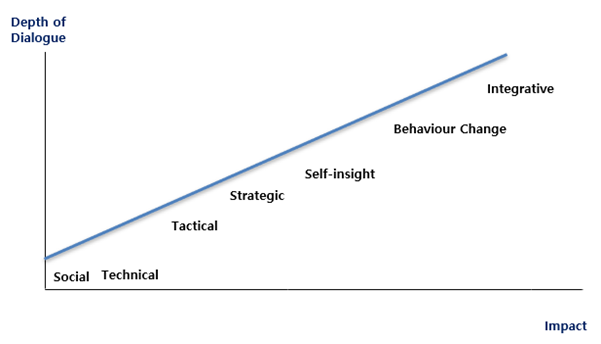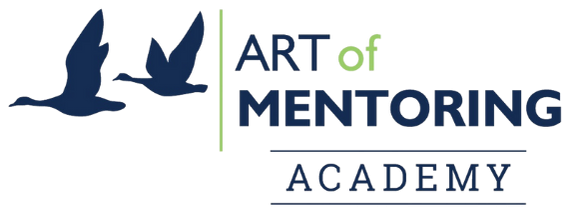Dialogue, particularly in developmental relationships, such as mentoring and coaching, can be regarded as having seven layers of increasing depth and impact.

Social dialogue
Is about developing friendship and providing support/ encouragement.
How to develop social dialogue:
- Demonstrate interest in the other person, in learning about them
- Actively seek points of common interest
- Accept the other person for who they are – virtues and faults, strengths and weaknesses
- Be open in talking about your own interests and concerns
Technical dialogue
Meets people’s needs for learning about work processes, policies and systems.
How to develop technical dialogue:
- Clarify the task and the other person’s current level of knowledge
- Be available when needed (just in time advice is always best)
- Be precise
- Explain the how as well as the why
- Check understanding
Tactical dialogue
Helps people work out practical ways of dealing with issues in their work or personal life (for example, managing time or dealing with a difficult colleague).
How to develop tactical dialogue:
- Clarify the situation (what do and don’t we know?)
- Clarify the desired and undesirable outcomes
- Identify barriers and drivers/ potential sources of help
- Establish fall-back positions
- Provide a sounding board
- Be clear about the first and subsequent steps (develop a plan, with timeline and milestones)
Strategic dialogue
Takes the broader perspective, helping people put problems, opportunities and ambitions into context (eg putting together a career development plan) and vision what they want to achieve through the relationship and through their own endeavours.
How to develop strategic dialogue:
Strategic dialogue uses the same skills as for tactical dialogue plus:
- Clarify the broader context (eg who are the other players in this issue?)
- Assess strengths, weaknesses, opportunities and threats
- Explore a variety of scenarios (what would happen if..?)
- Link decisions and plans closely to long-term goals and fundamental values
- Consider radical alternatives that might change the game (eg could you achieve faster career growth by taking a sideways move into a completely different function?)
Self-insight dialogue
Enables people to understand their own drives, ambitions, fears and thinking patterns.
How to develop dialogue for self-insight:
How to develop dialogue for self-insight:
- Ensure you are both willing to be open and honest with yourselves and each other
- Give time and space for each other to think through and come to terms with each item of self-knowledge
- Be aware of and follow up vague statements or descriptions – be rigorous in analysis of what each of you say
- Explore the reasons behind statements – wherever possible, help each other establish the links between what you say / do and underlying values/ needs
- Introduce tools for self-discovery – for example, self-diagnostics on learning styles, communication styles, emotional intelligence or personality type
- Challenge constructively – (“Help me to understand how/why…”)
- Give feedback from your own impressions, where it will help the other person reflect on how they are seen by others
- Help each other interpret and internalise feedback from other people (eg 360 appraisal)
Behavioural change dialogue
Allows the mentee to meld insight, strategy and tactics into a coherent programme of personal adaptation.
How to develop dialogue for behavioural change, all the above, plus:
- Help each other to envision outcomes -- both intellectually and emotionally
- Clarify and reinforce why the change is important to the other person and to other stakeholders
- Establish how they will know they are making progress
- Assess commitment to change (and if appropriate, be the person to whom they make the commitment)
- Encourage, support and express belief in their ability to achieve what they have committed to
Integrative dialogue
Helps people develop a clearer sense of who they are, what they contribute and how they fit in. It enables the mentee to gain a clearer sense of self and the world around them; to develop greater balance in his or her life, and to resolve inner conflict. It explores personal meaning and a holistic approach to living.
How to develop integrative dialogue:
More than any other form of dialogue, this is usefully characterised as a dance, in which both partners take the lead in turns, often exchanging rapidly. It involves:
- Exploring multiple, often radically different perspectives
- Shifting frequently from the big picture to the immediate issue and back again
- Asking and answering both profound and naïve questions (often it is difficult to distinguish between them!)
- Encouraging each other to build a broader and more complex picture of himself or herself, through word, picture and analogy
- Helping someone write their story – past, present and future
- Analysing issues together to identify common strands and connections
- Identifying anomalies between values/ what is important to the mentee and how they behave
- Making choices about what to hang on to and what to let go
- Helping them develop an understanding of and make use of inner restlessness, and/or helping them become more content with who and what they are
The most effective people developers invest considerable time and effort in building their repertoire of skills, so they can both recognise the appropriate level of dialogue to apply at a particular point, and engage others appropriately. Very often, the other person has little or no experience of operating at the deeper levels of dialogue, so you have to work with them to establish successive layers of competence, one by one.
In some cases – for example, alienated teenage criminals with poor education and low self-esteem – even social dialogue is a struggle. It may take many sessions of building trust and practicing dialogue, before you can even begin to explore deeper issues together. Patience is an overarching quality that permeates all seven layers of dialogue.

